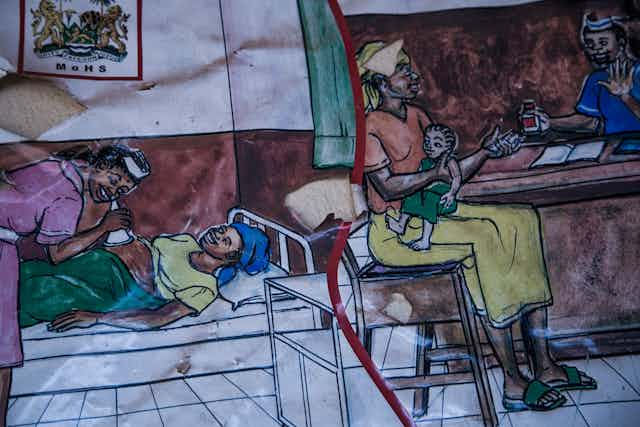Globally, nearly 300,000 women die from pregnancy-related causes each year. Most of these deaths are in the low-income countries of sub-Saharan Africa and South Asia.
The leading causes of maternal mortality include severe bleeding, hypertensive disorders, infection, unsafe abortion and embolism. There are also indirect causes such as HIV, malaria and anaemia. About three in four maternal deaths could be prevented if women had adequate access to quality care before, during and after pregnancy.
Quality antenatal care can save lives by identifying and addressing health problems that can cause pregnancy complications and poor birth outcomes. But the women most at risk tend to be the ones who do not access life-saving health services. Barriers to quality antenatal care include lack of information, cultural practices, poverty and distance to health services. Others are inadequate and poor health services.
There is already global evidence of social and economic differences in access to maternal health care and the quality of that care. We sought to understand the quality of antenatal care in sub-Saharan Africa. Countries in the West and Central African sub-region have notably poor reproductive health indicators, as well as high levels of poverty and civil unrest or political fragility.
Yet, the region has been largely underrepresented in empirical research. Research findings can help inform policy and programme interventions for improving the reach and quality of antenatal care. They can also contribute to reducing the unacceptable rates of maternal and newborn deaths in the region.
At the time of our study, household survey data from the same source were available for seven countries in the United Nations region of West and Central Africa: Central African Republic (CAR), Chad, the Democratic Republic of Congo (DRC), Ghana, Nigeria, Sierra Leone and Togo. We analysed the data on 32,718 women whose pregnancies resulted in a live birth, considering the levels of poverty in the households and communities where these women resided.
What we found
Our findings indicated that one in four pregnant women did not receive antenatal care. The majority of these women were in Chad (37%) and Nigeria (38%). Among women who had antenatal care, the majority received low-quality care. This means receiving fewer than five of six possible antenatal care services. The proportion of women who received high quality antenatal care ranged from 3% in Chad to 33% in Nigeria.
Among women who received antenatal care, the most common services provided across all seven countries were blood pressure monitoring and tetanus vaccination. The figures ranged from 79% in Chad to 99% in Ghana for blood pressure monitoring. For tetanus vaccination they ranged from 87% in the DRC to 97% in Sierra Leone.
Less frequently provided services included HIV testing, malaria treatment and blood tests. We also found that higher levels of household wealth increased the likelihood of women reporting high-quality antenatal care. Poorer households are in the top 20% of the household wealth index. This measures the living standard of a family, based on the possession of certain household goods and infrastructure. The relationship of household wealth with quality of antenatal care was more noticeable in the DRC, Ghana, Nigeria, Sierra Leone and Togo.
Similarly, women who had secondary or higher levels of education were between two and three times as likely to receive high-quality antenatal care as women without formal education. With the exception of Chad, women who had more antenatal care visits reported high quality care.
Our results indicate that the quality of antenatal care varied according to the level of poverty in communities. Women who lived in poor communities were between 15% and 52% less likely to report high-quality antenatal care. Poor communities are clusters of households headed by someone with no formal education, and in the lowest 20% of the wealth index. The poorest household wealth quantile is the lowest 20%.
The findings indicate that living in a poor household and in close proximity to poor households is a risk factor for low quality antenatal care. Poor women and their families are already vulnerable and may have underlying conditions that can increase their risks for experiencing pregnancy complications and poor birth outcomes. But these women may miss out on the benefits of antenatal care altogether because they face financial and social barriers to healthcare.
What should be done
In countries with low coverage of antenatal care, for instance Chad and Nigeria, policies should focus on expanding access to maternal health services. Educational policies that support the enrolment and retention of women in school can contribute to raising awareness on health and well-being. They also empower women to demand quality care. Although some countries provide free or subsidised health services for pregnant women and young children, it is evident that these policies do not adequately bridge the gap between need and access to services.
Therefore, additional economic policies that empower women financially to afford direct and indirect costs of services are needed.
Across all the countries in our study, there is a dire need to improve the quality of services. The health systems are clearly missing an important opportunity to intervene early in pregnancy to address behaviours and health problems that could cause serious complications or pregnancy-related deaths among the poorest women.
Targeted support for health systems should also be provided. These include ensuring adequate supplies of medicines and equipment, enhanced pre-service and in-service training and supervision of healthcare providers. Equitable distribution of healthcare resources, including providers, would also contribute to improved access and quality of antenatal care services in West and Central Africa.
These recommendations, if implemented, would significantly reduce maternal and newborn deaths and increase wellbeing and social capital in the region.

